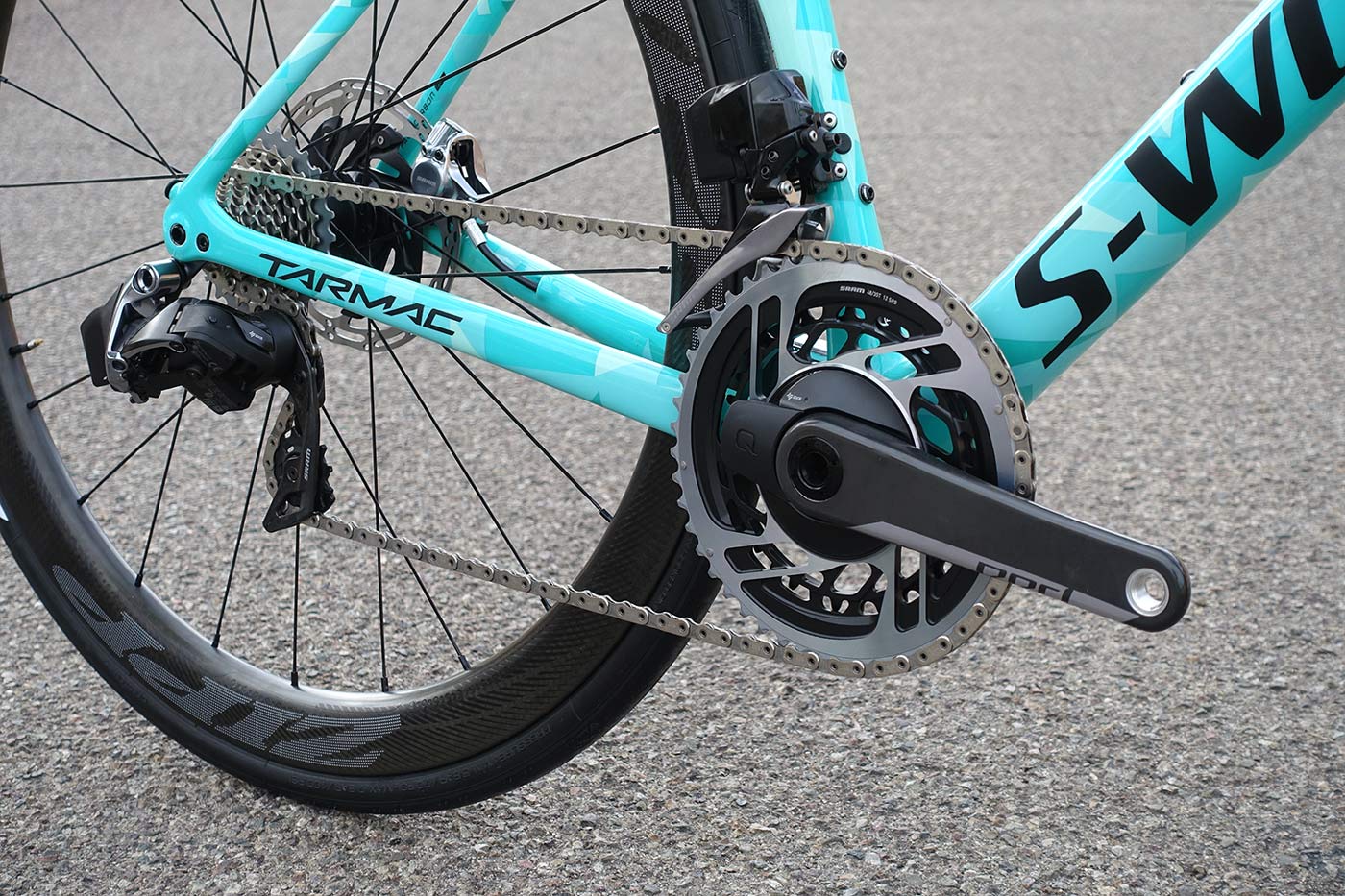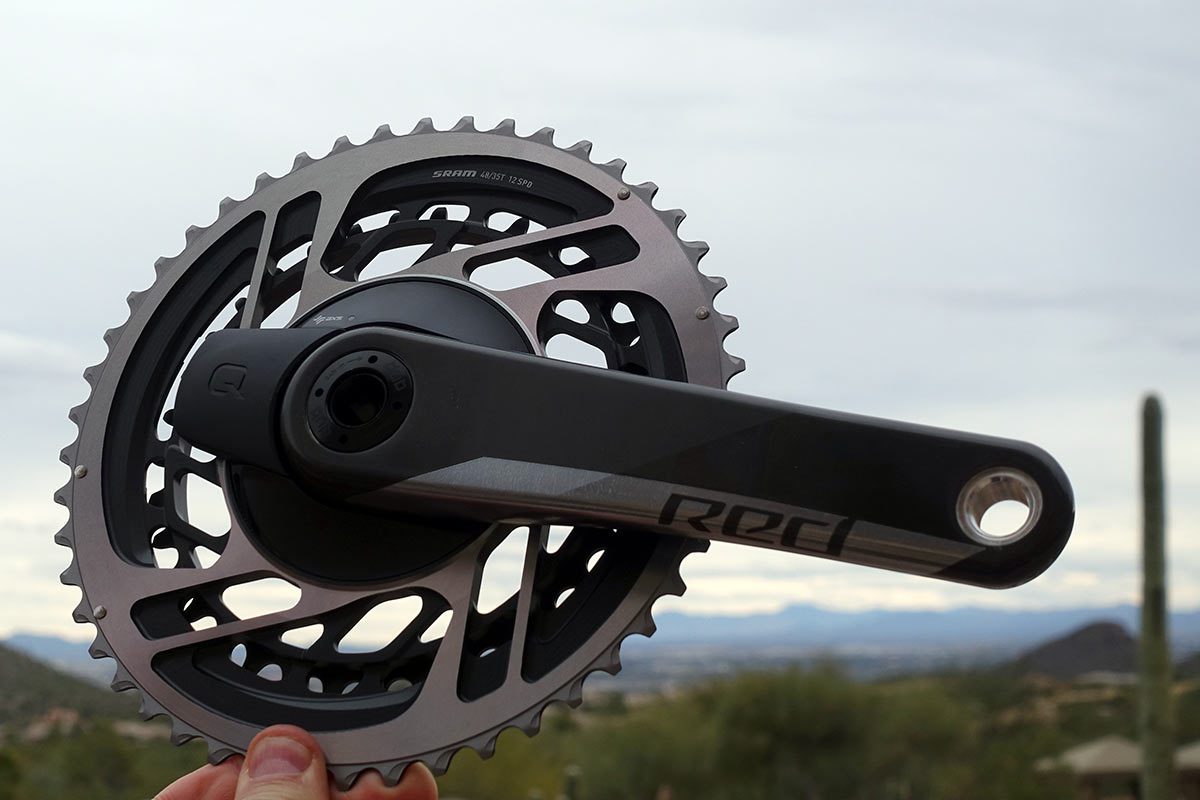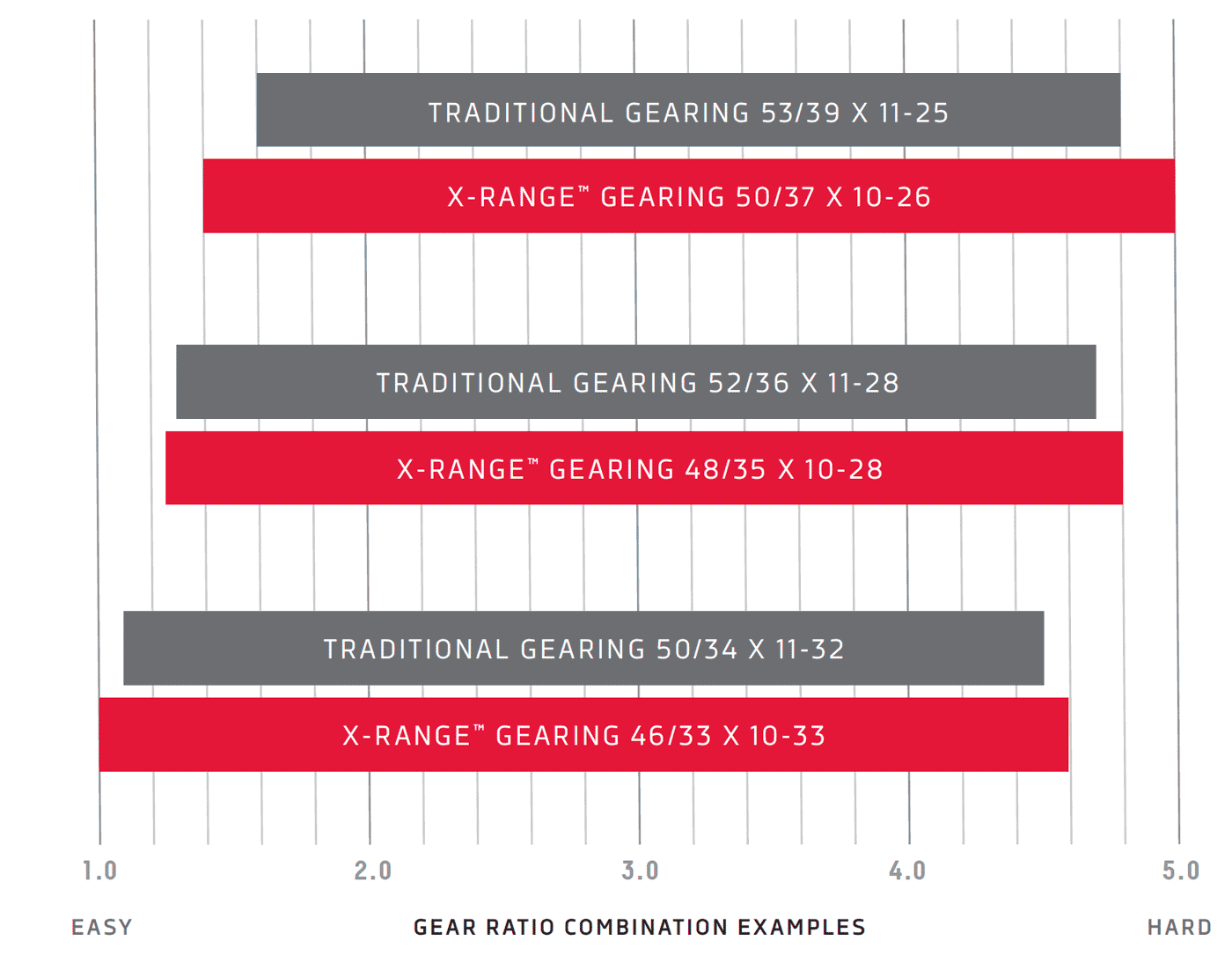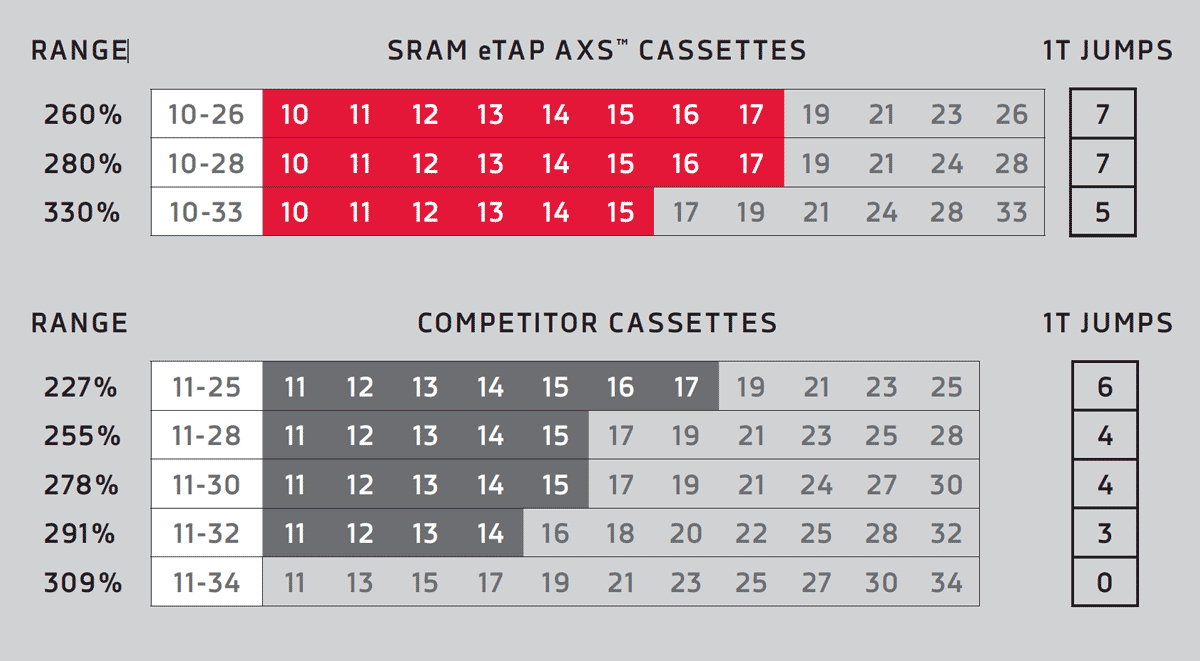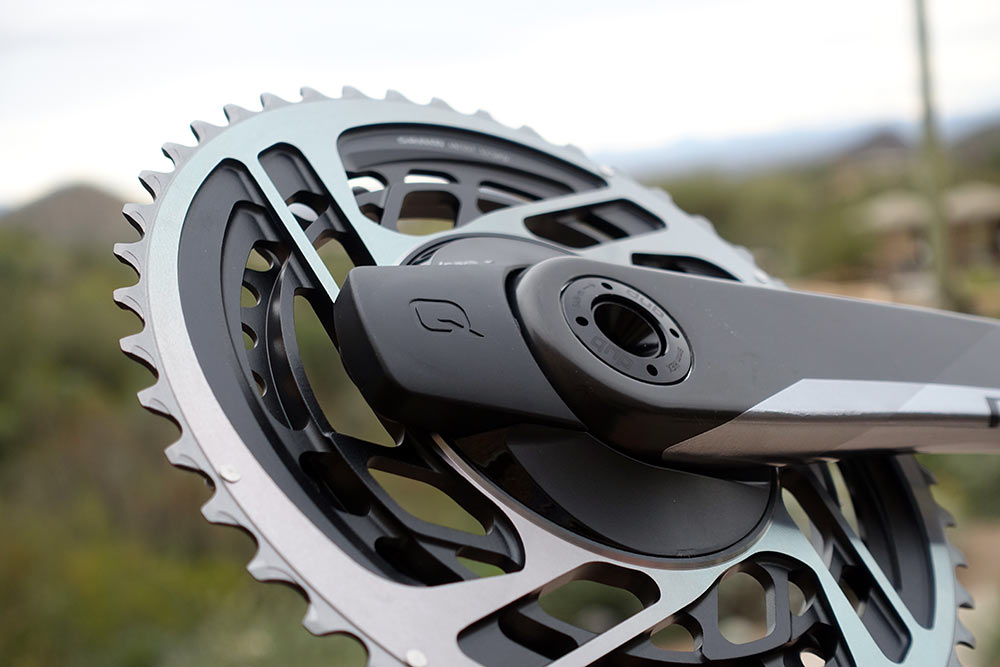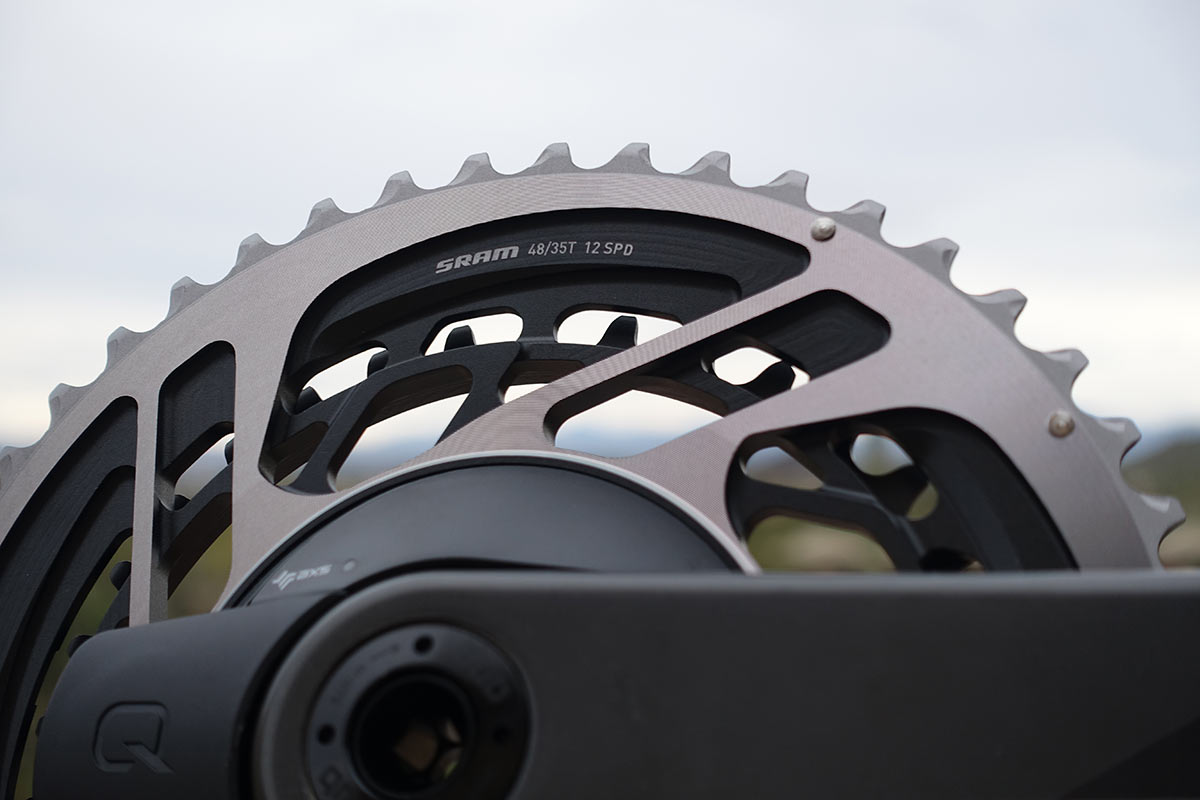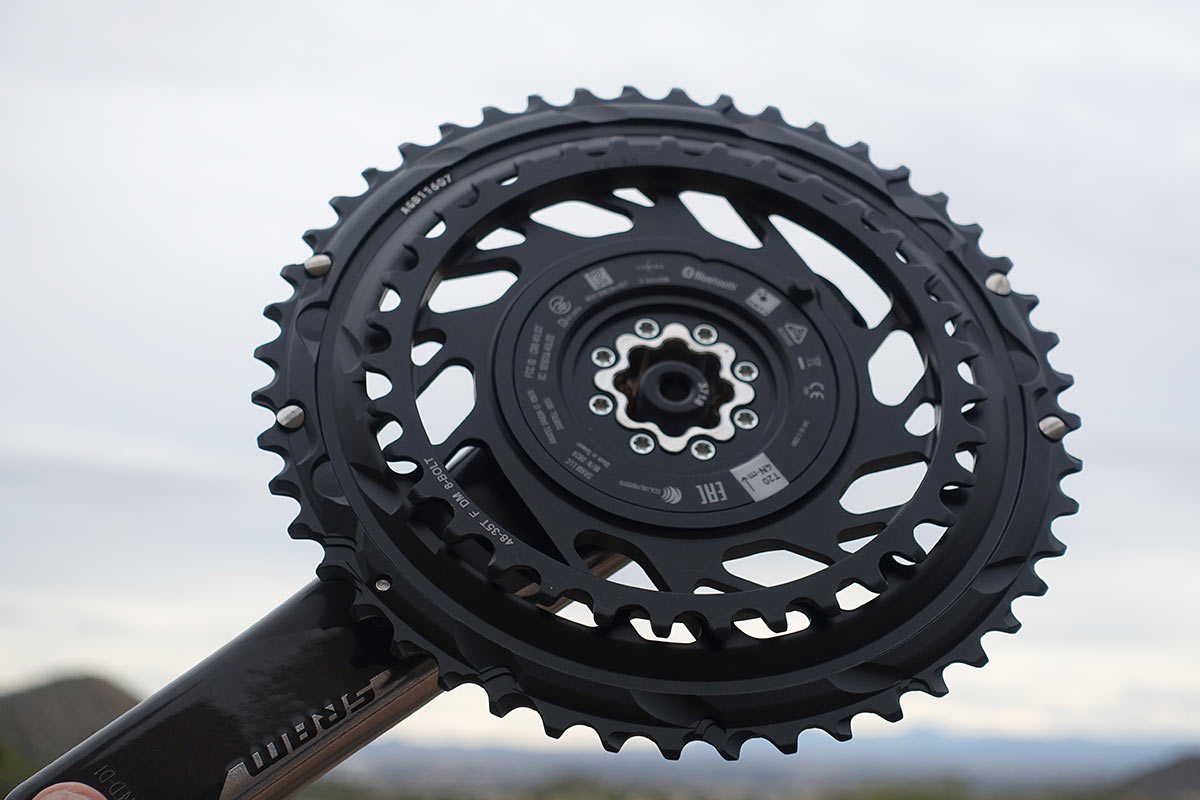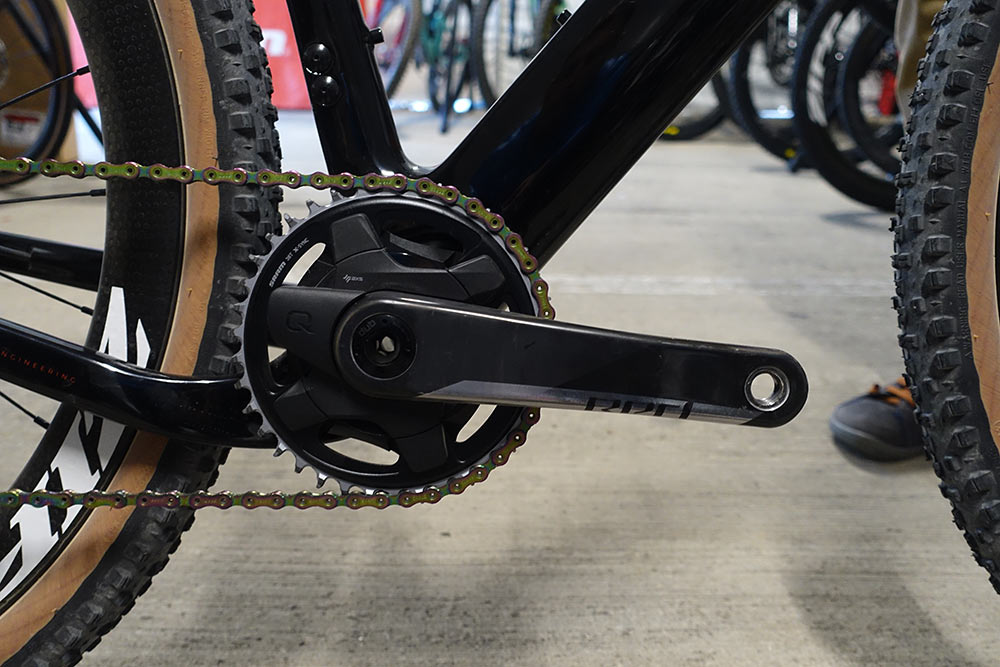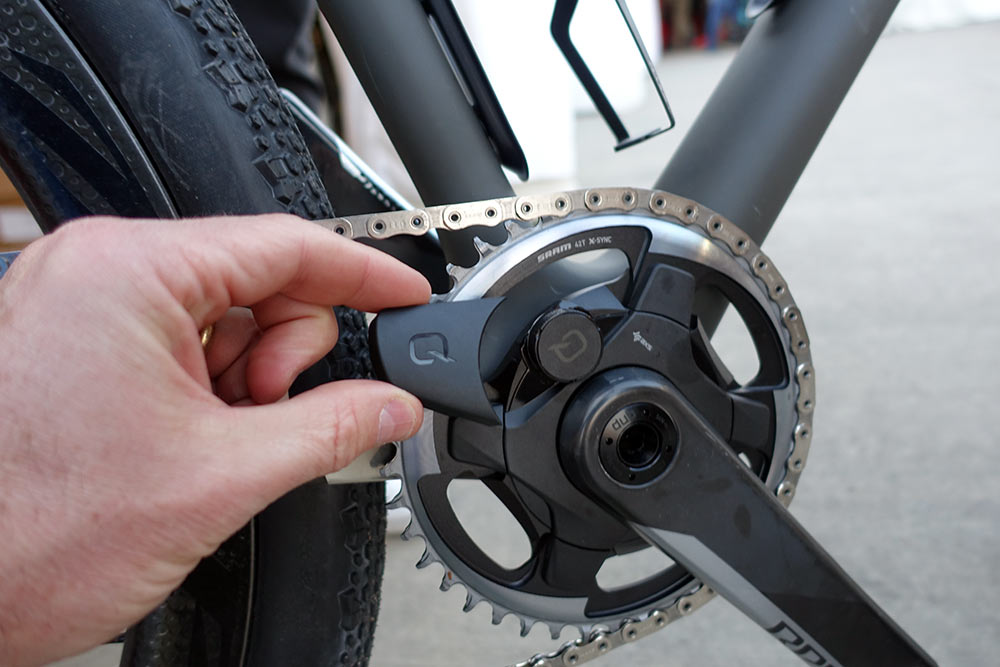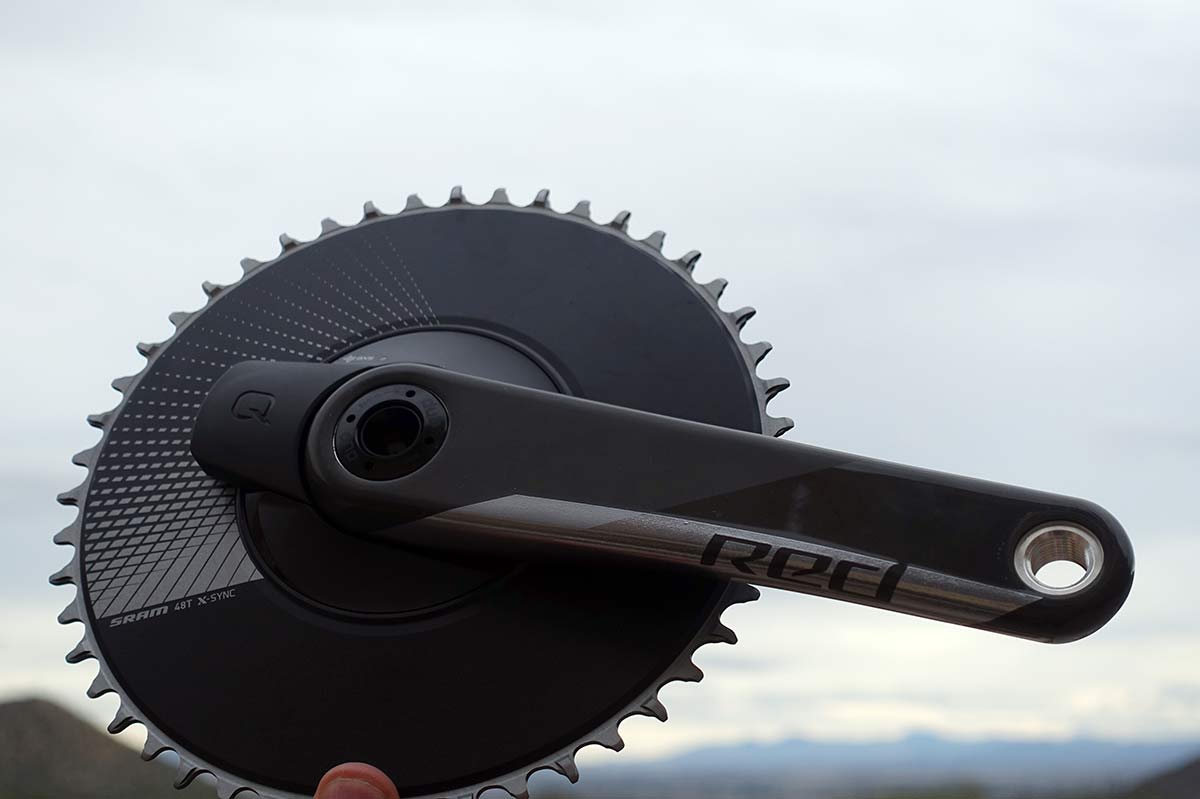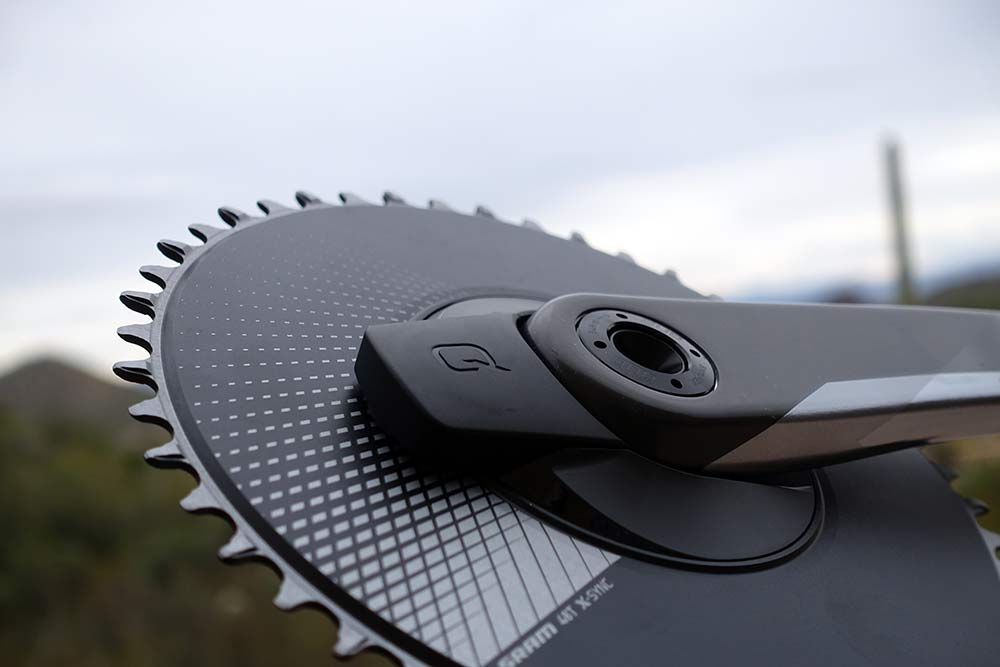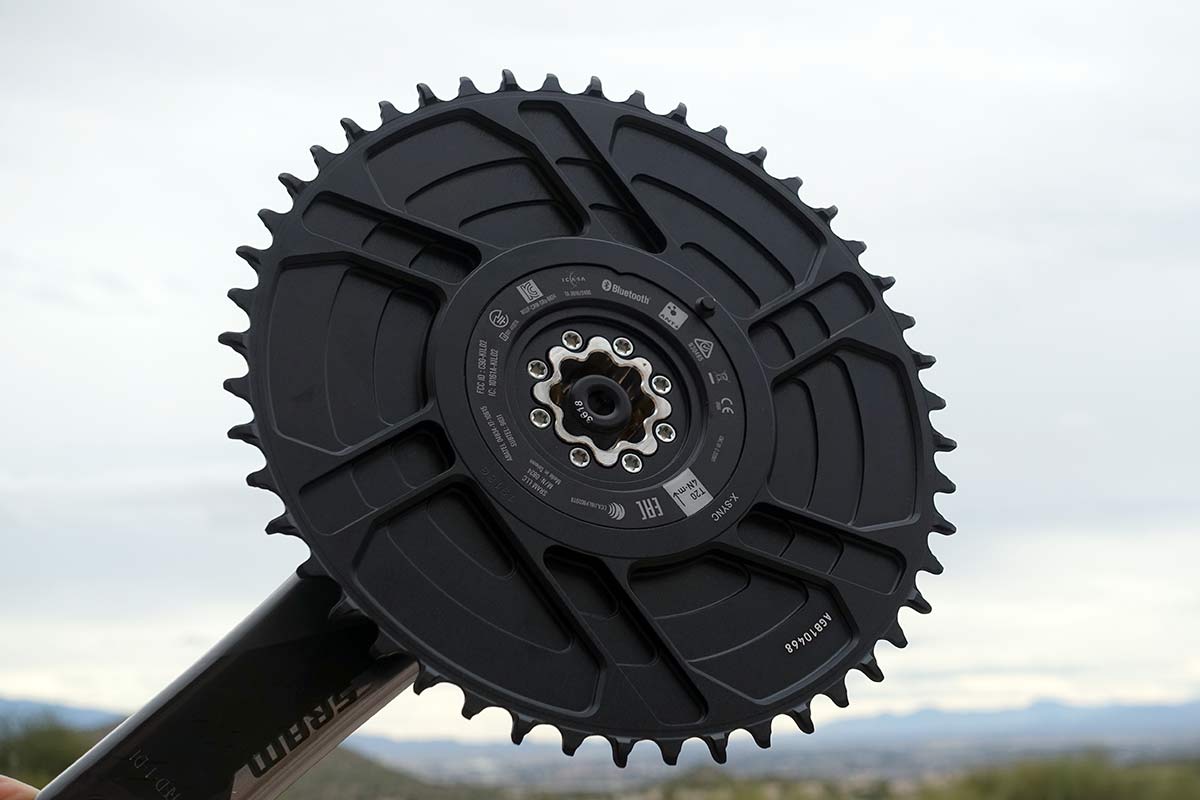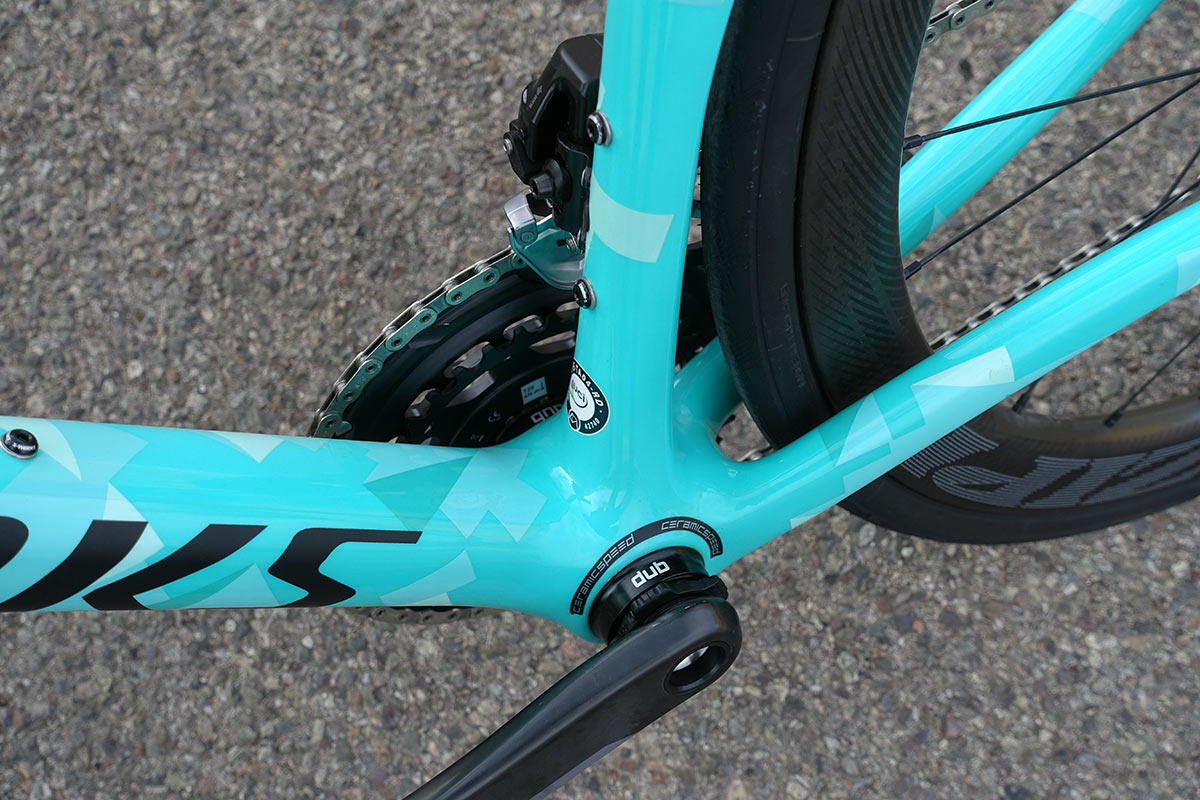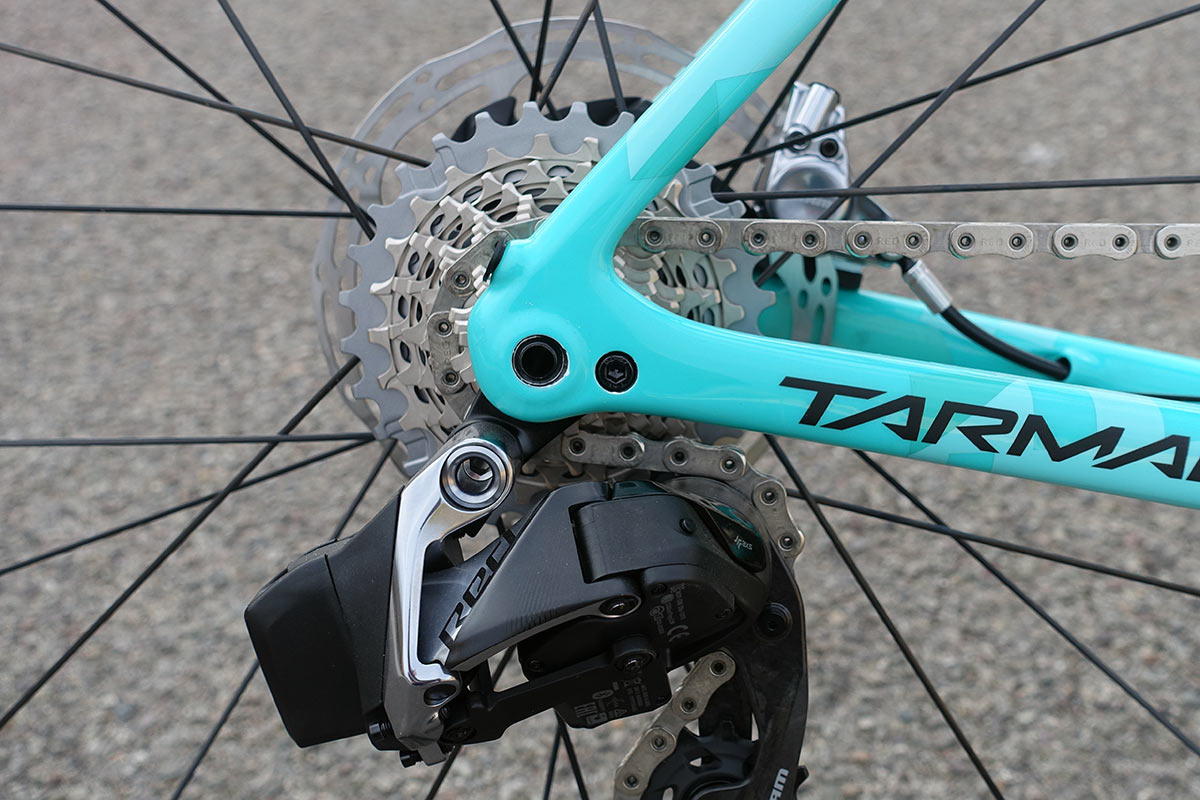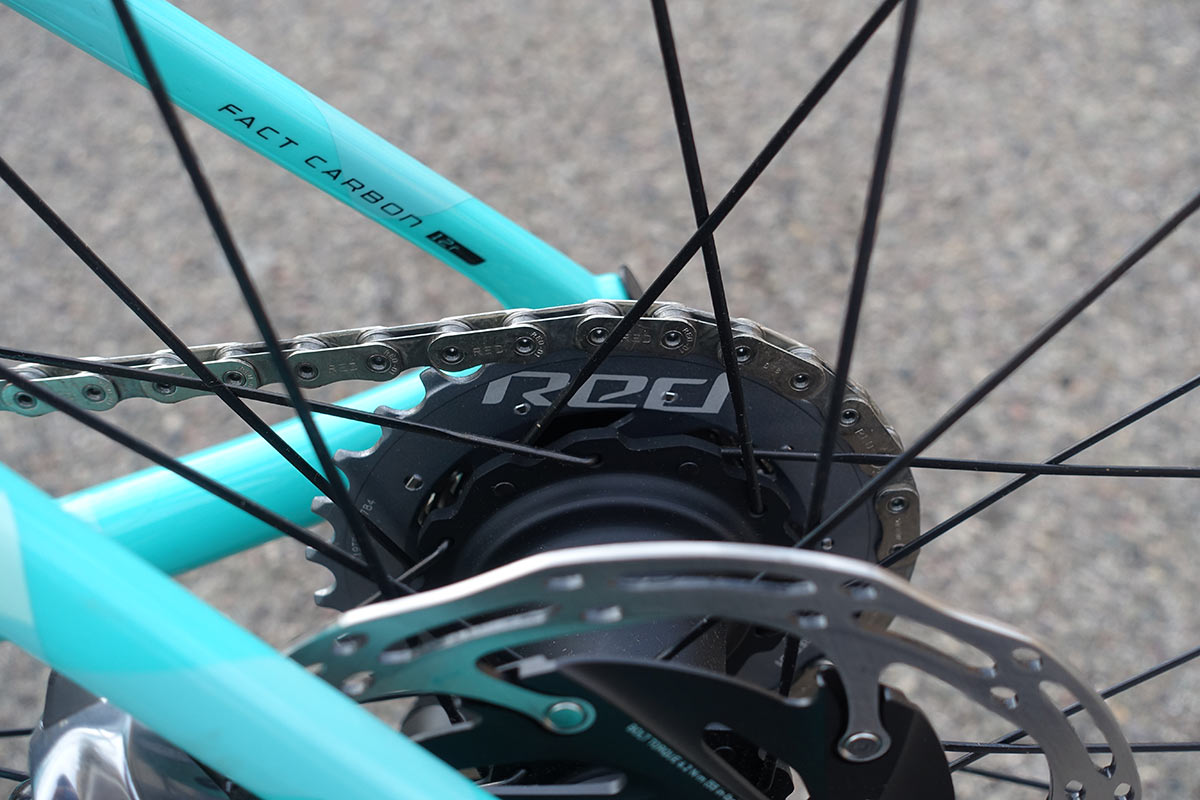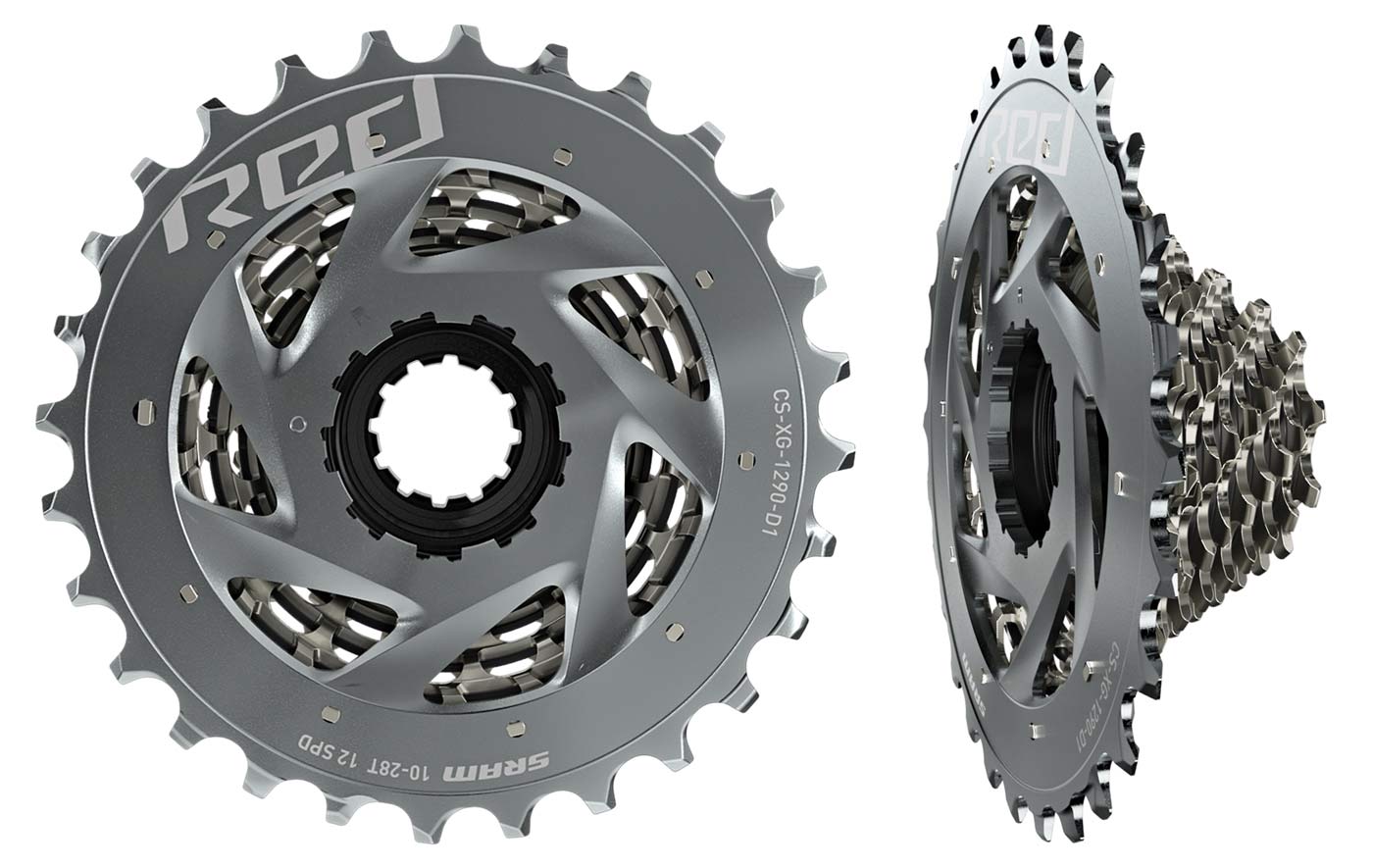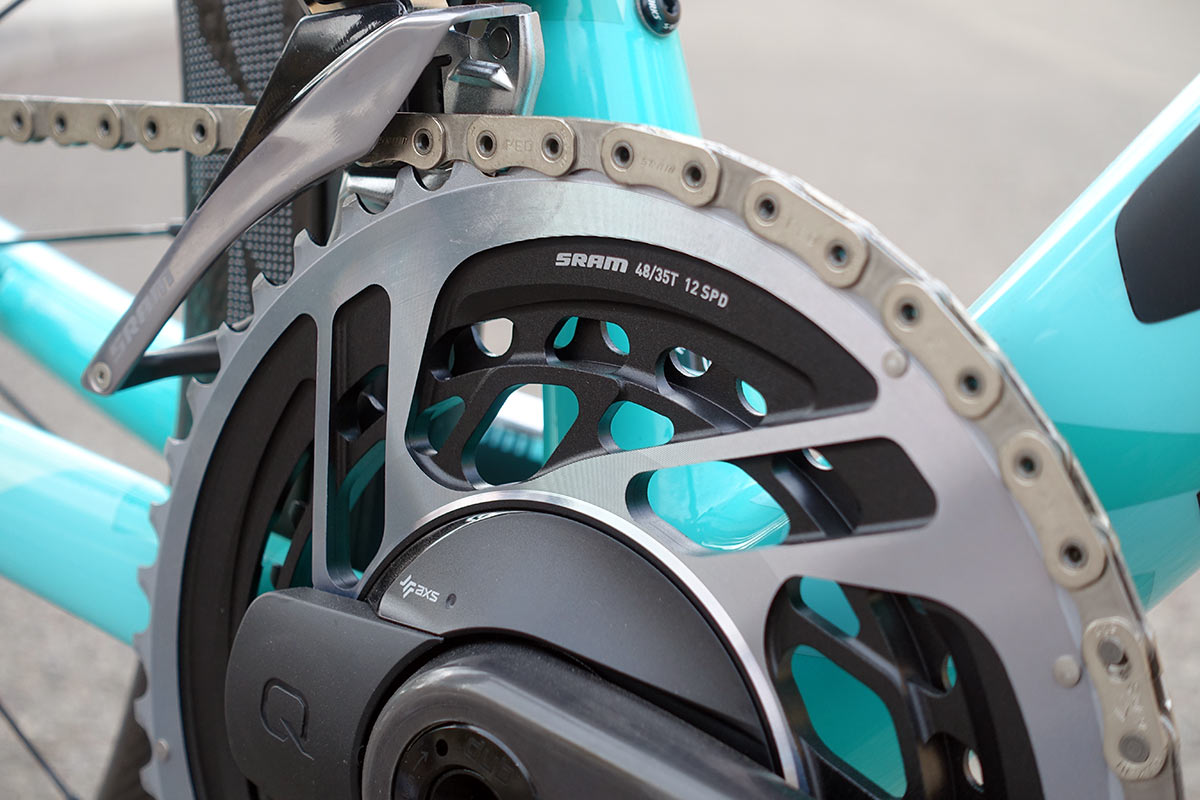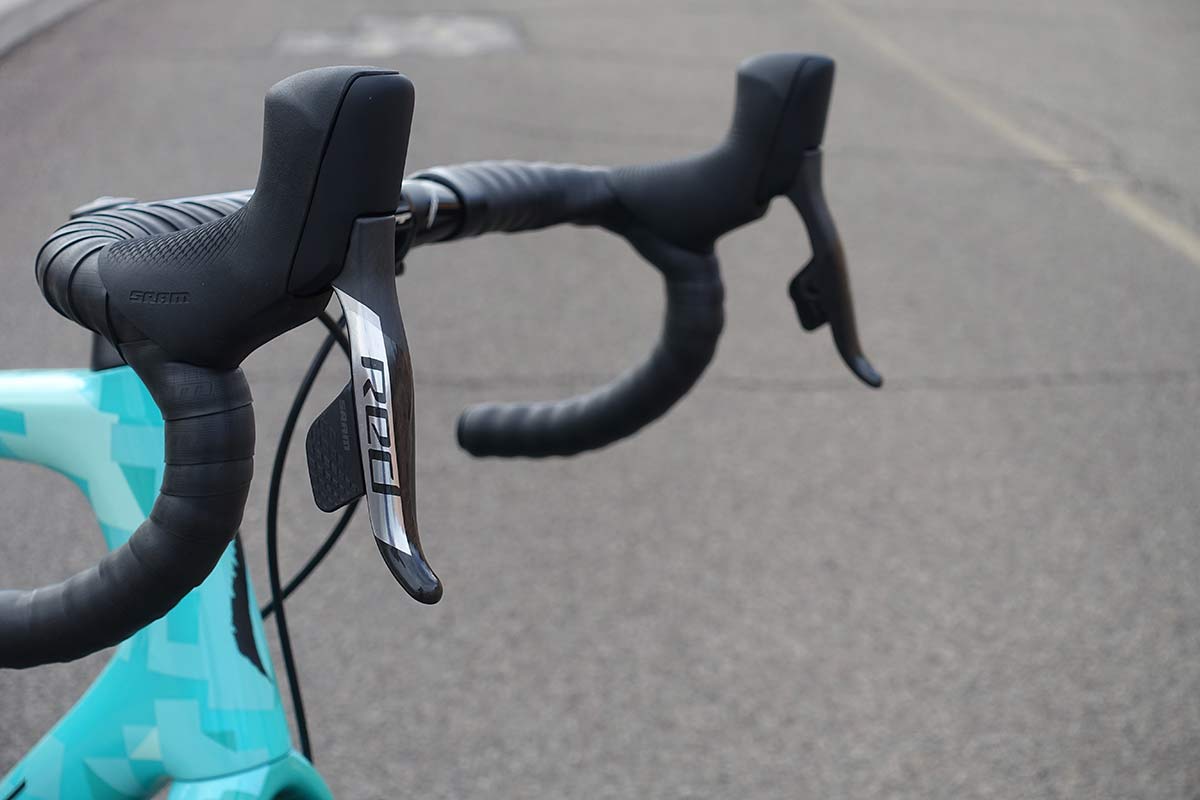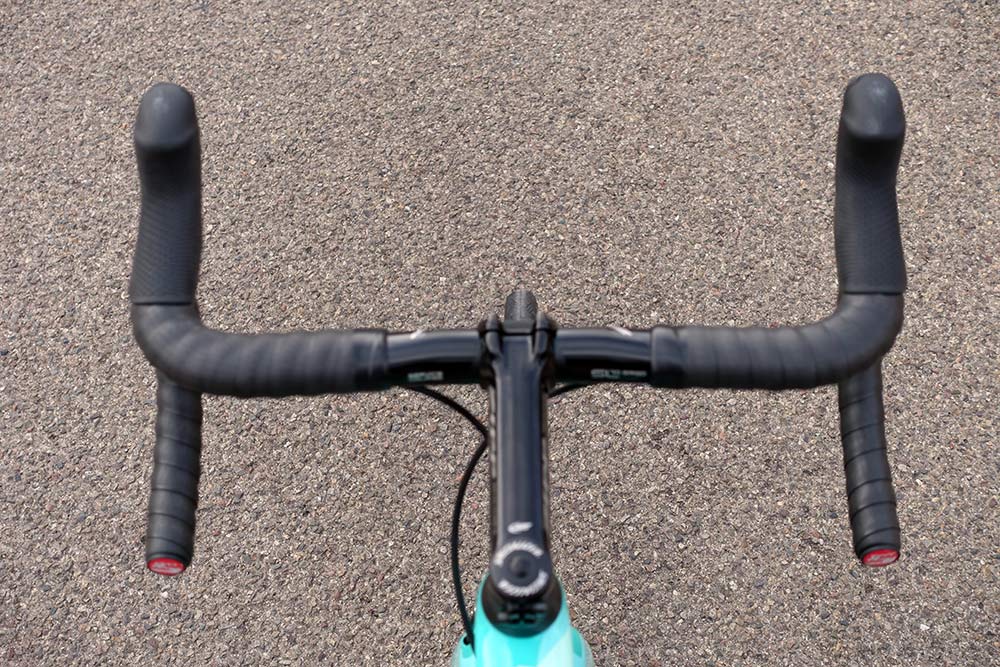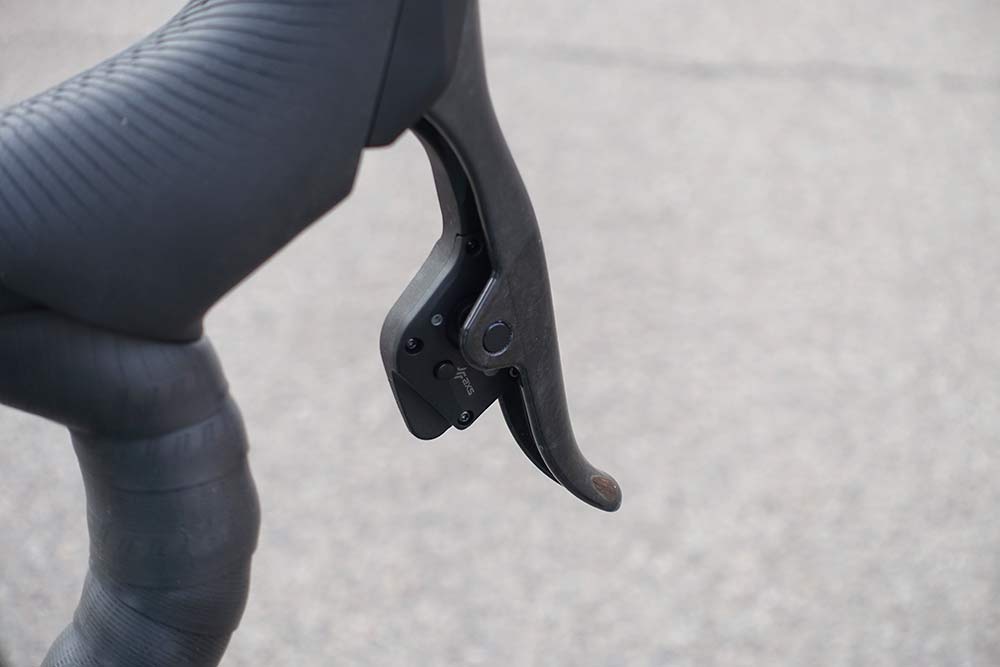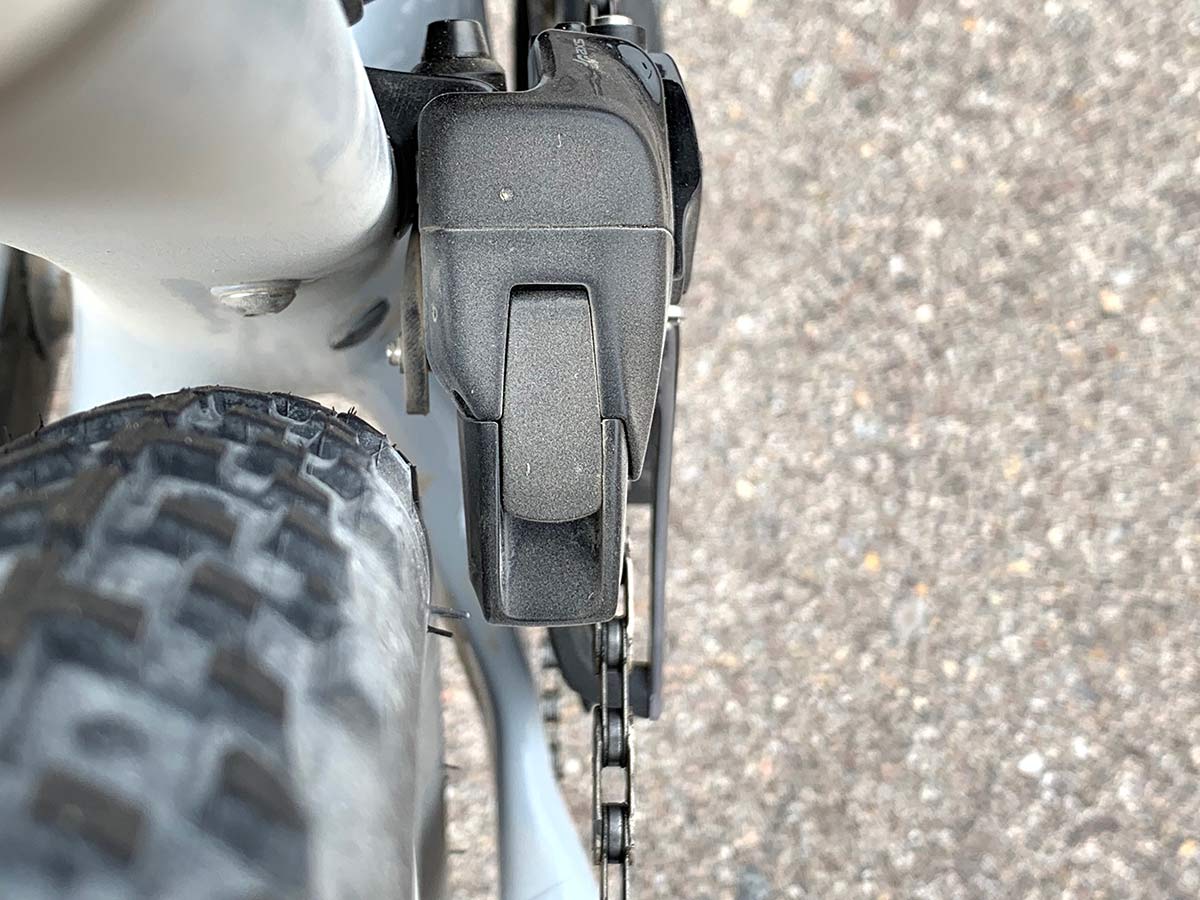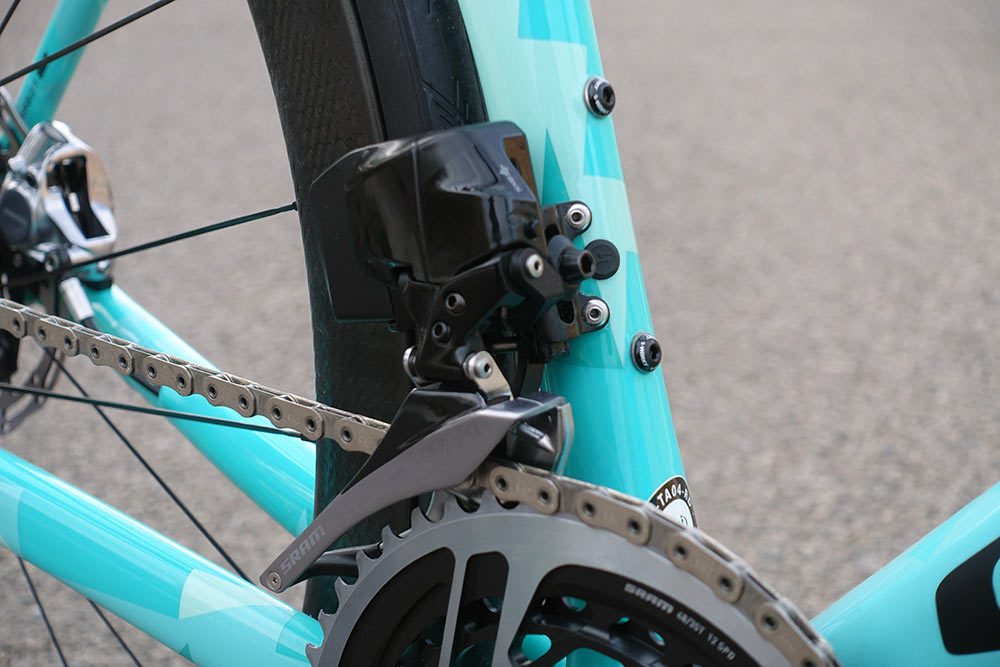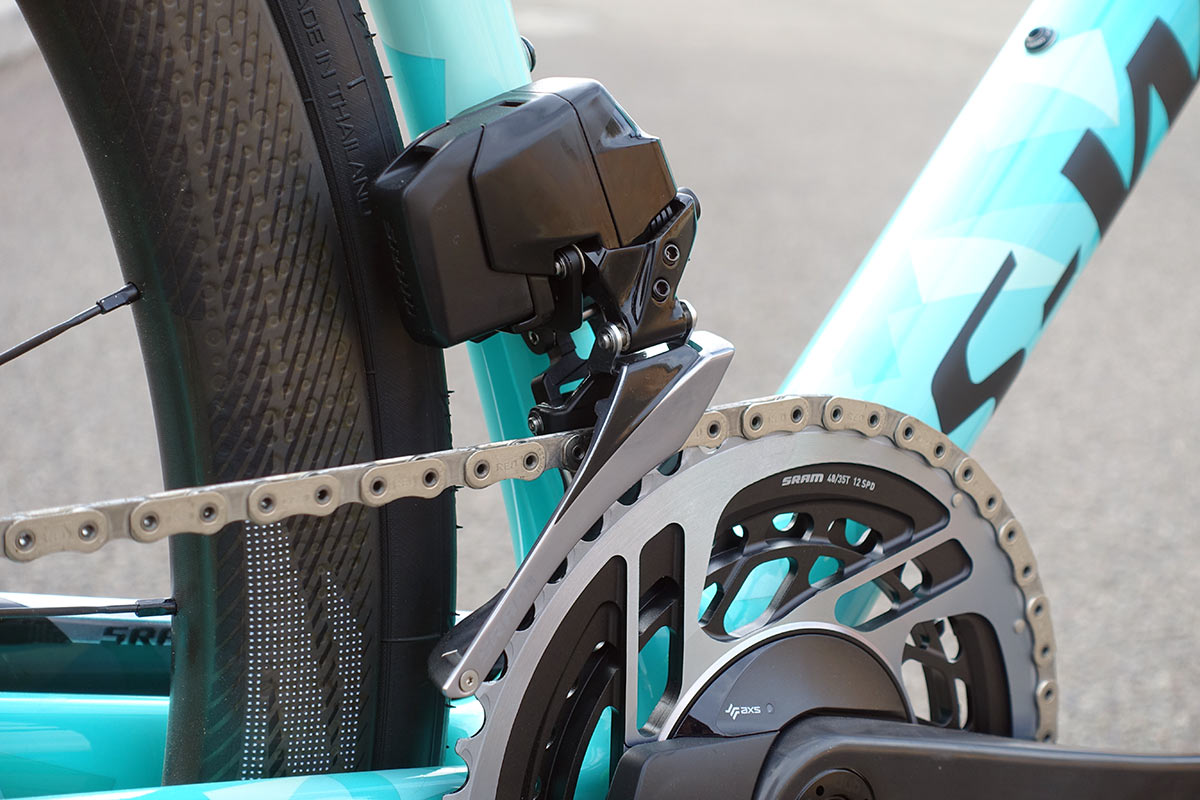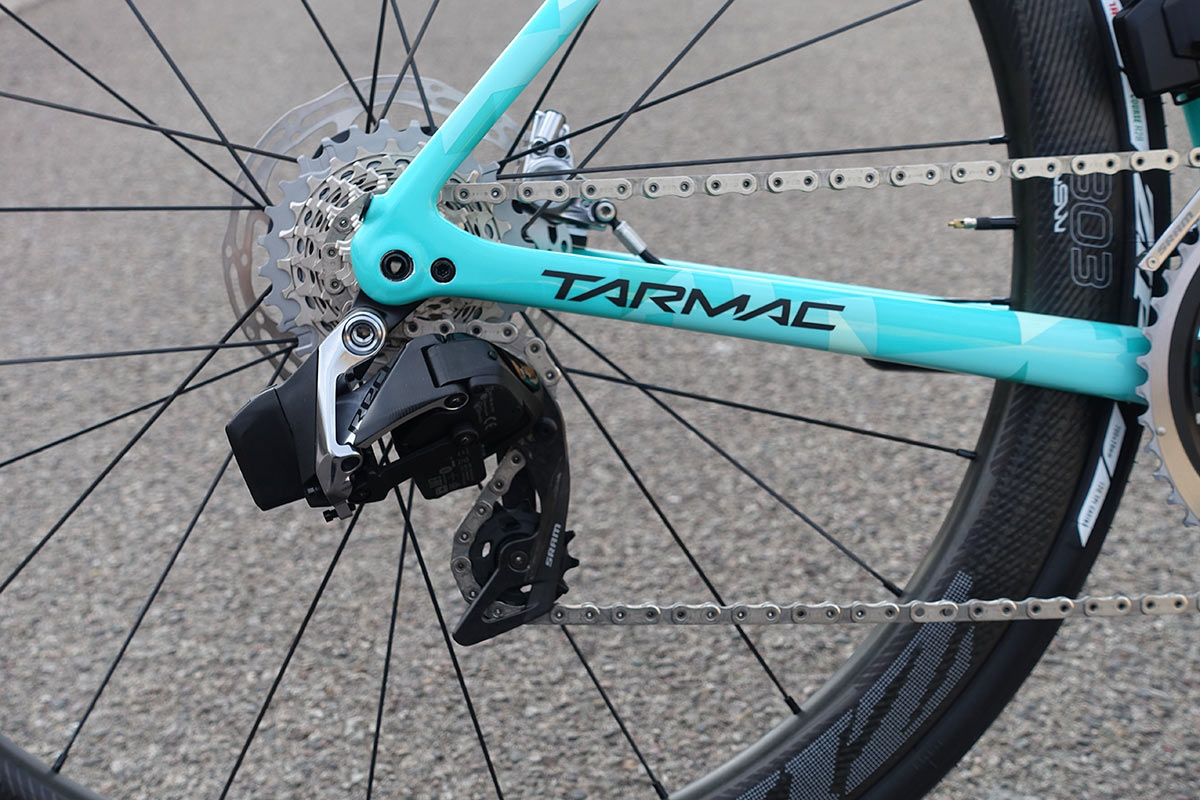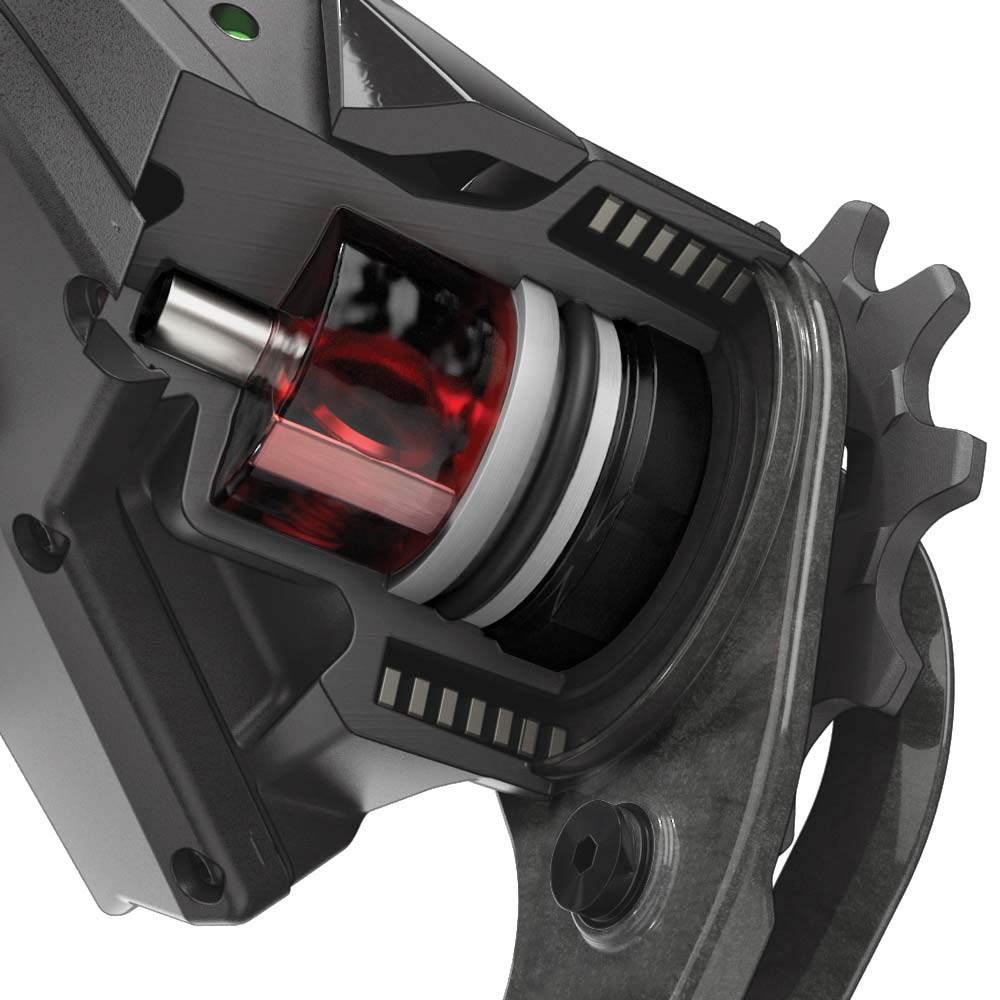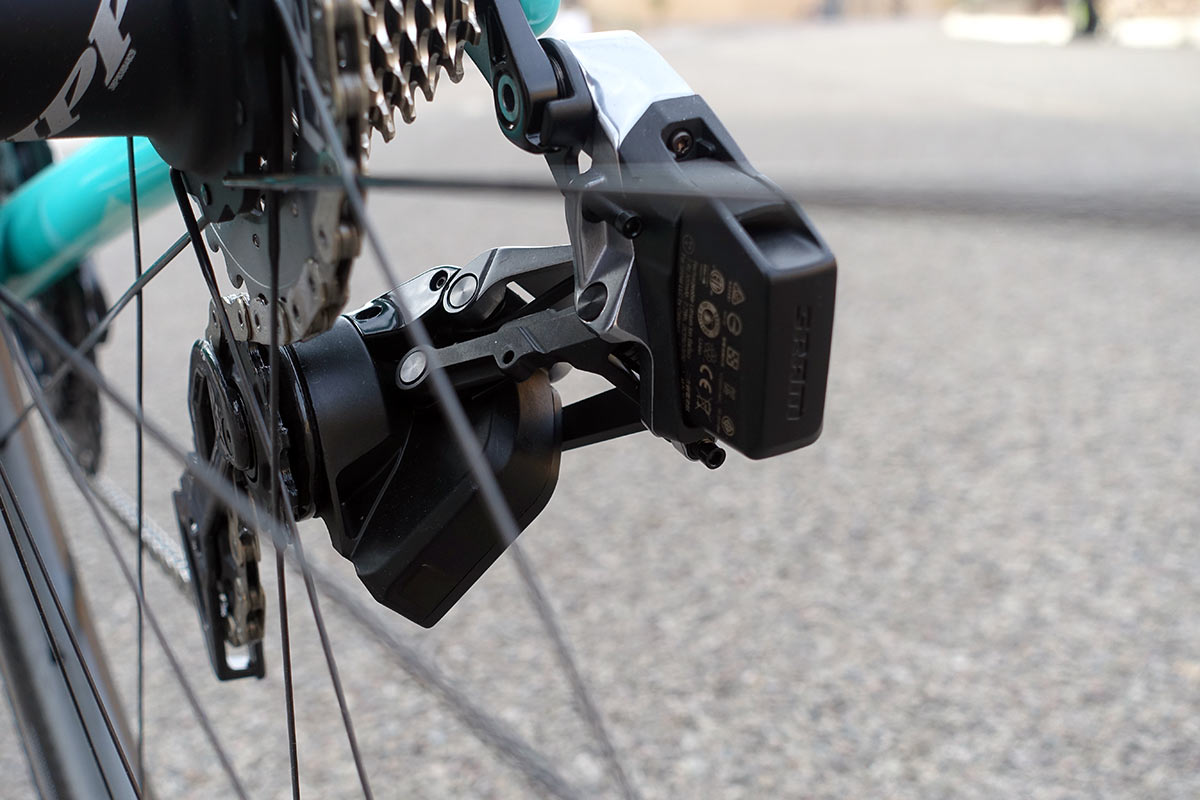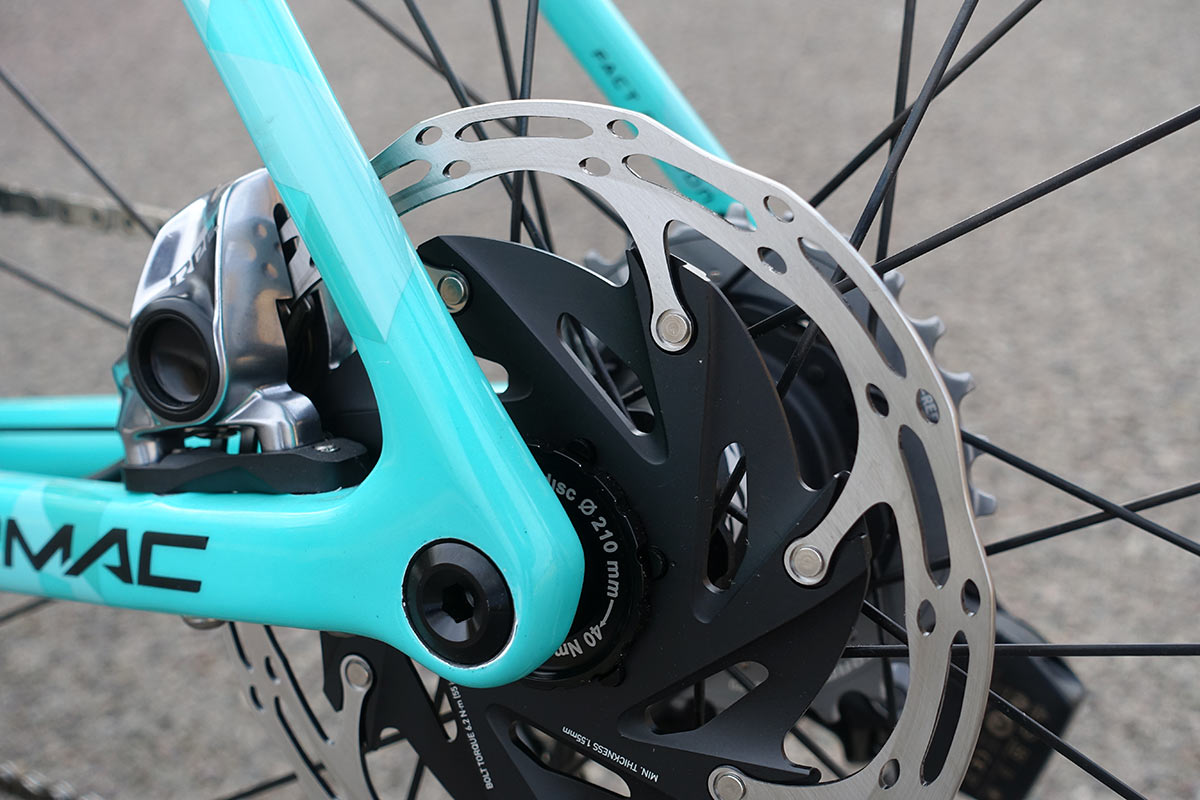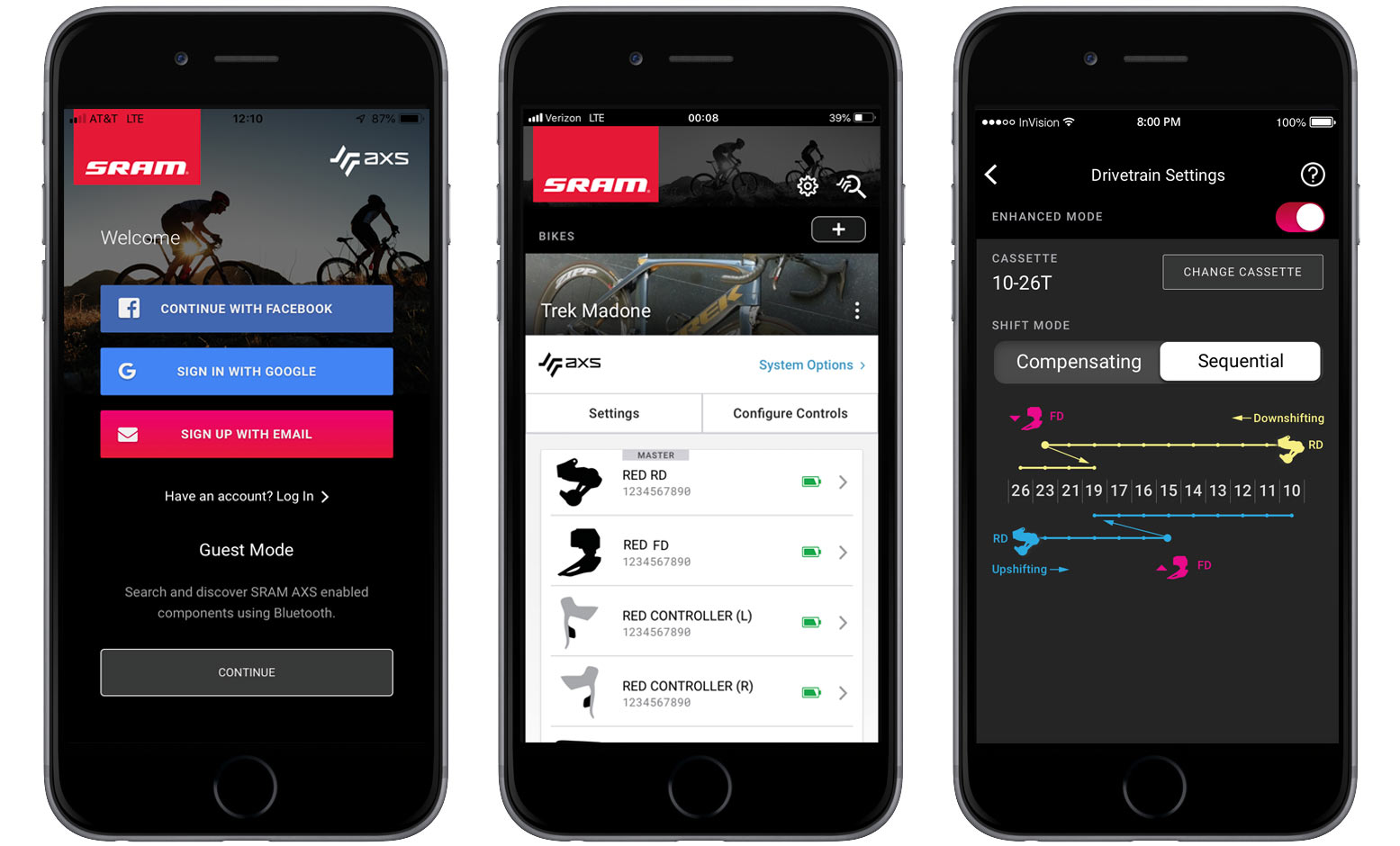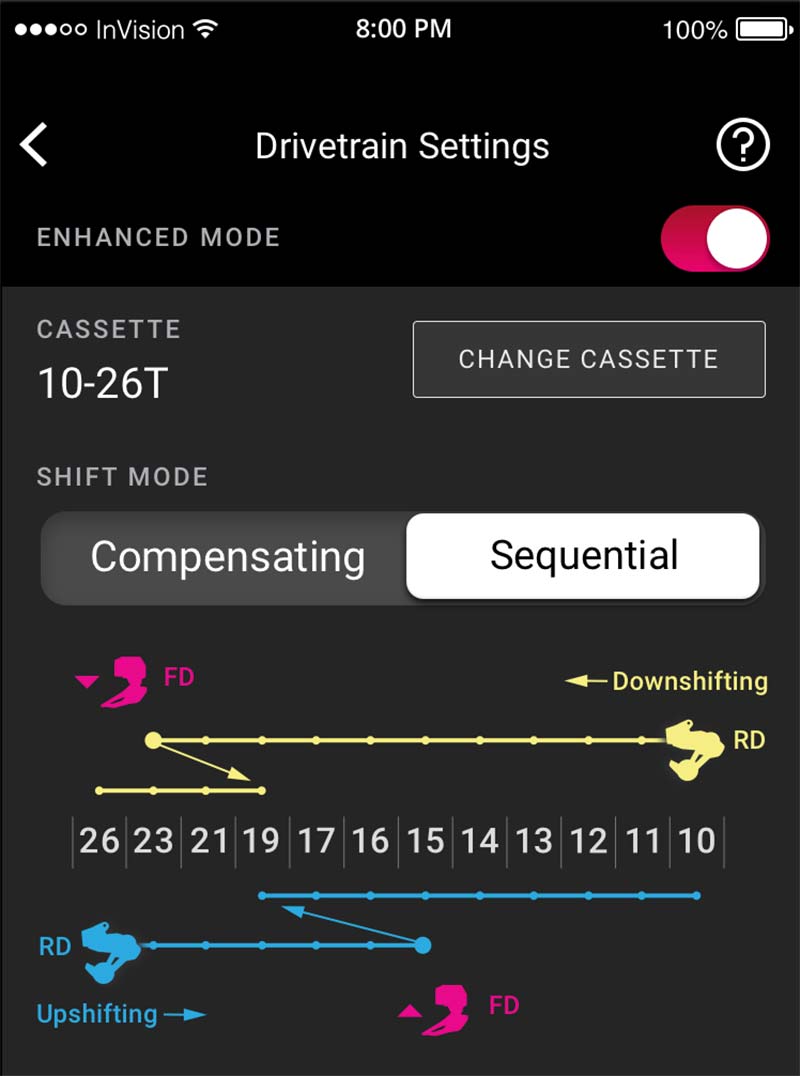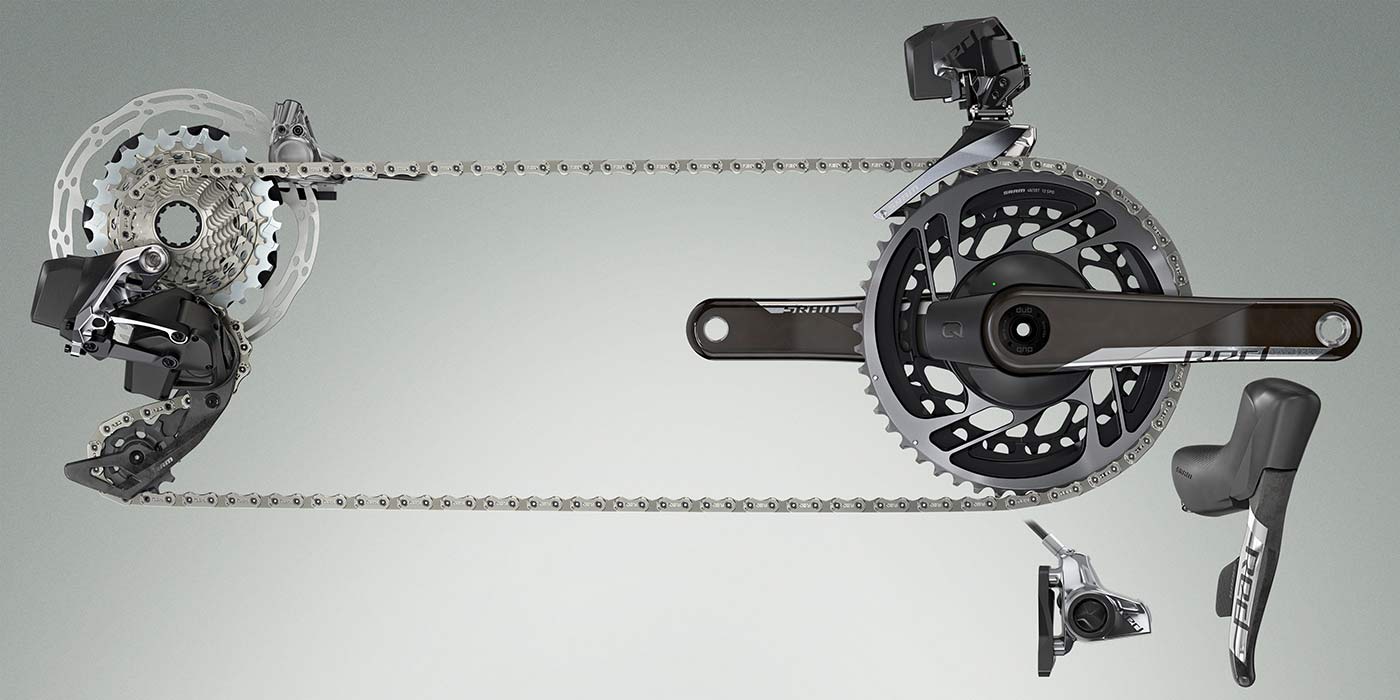The all-new SRAM RED eTap AXS road bike group with 12-speed wireless electronic shifting takes everything they learned from the original eTap group and makes it better. Actually, it takes everything they learned from all of their road groups -design, shifting, noise, and more- and makes that better, too. The new RED group is a complete rethink of what road bike drivetrains should be, and the addition of a cog is only the beginning!
First, the wee bit of bad news. None of the original Red eTap components are compatible with this new group, for a number of reasons – geometry of the derailleurs, new electronic chips, another cog, new chain, etc., the list goes on as you’ll see.
Red eTap came out about three years ago, and it’s great. But there have been big changes in the road riding market in that time, and electronics continued their steady march of improvement. So they made a new group. All new. The only thing that’s the same is the battery and the hydraulic brake master cylinders in the hoods. OK, and the Blip buttons. But that’s it. Which means all new components, but also new chainring sizes and a new philosophy on gearing…
Mechanical improvements & new gear combos
If we’re being honest, it’s kinda surprising that no one’s rethought chainring sizes for decades. Yes, we’ve added compact and 1x, but the standard road bike has used the same basic gearing combos for a long, long time. Yet, the ways we ride and our knowledge of how our bodies work has changed dramatically. And now, on this group, so does the gearing.
The derailleurs are new, with only one version each for front and rear. Which means only one cage length that works on any of their gear combos. To do this, they took some of the range from the front and moved it to the cassette. The effect is that you can stay in the same chainring longer, and steps between gears in the back are more consistent. Before, the typical combos with traditional chainrings are:
- 53/39 with 11-25 cassette
- 52/36 with 11-28 cassette
- 50/34 with 11-32 cassette
The new X-Range gearing changes that up, keeping a consistent 13-tooth difference between small and large chainrings for all options. The new combos are:
- 50/37 with 10-26 cassette
- 48/35 with 10-28 cassette
- 46/33 with 10-33 cassette
These new combos offer range that’s essentially the same or greater than the traditional gearing it replaces, thanks in large part to the new 10-tooth small cog on the cassette. The range is equivalent to 260%, 280% and 330%, respectively.
On the small end of the cassette, they keep 1-tooth jumps for longer than the equivalent standard cassette, which means it’s easier to find the right cadence in more of the cassette. It also means you’re likely to stay in the big ring longer.
So, what about efficiency loss with going to a smaller cog in the back? They say that, first, you’d be hard pressed to measure the difference. And second, you’d be harder pressed to actually notice it on the bike. Technically, yes, a smaller diameter bend in the chain will have more friction. But, SRAM’s Road Drivetrain product managers explain (and can back it up with data) that when you have that smaller radius, chain tension is higher, which actually increases efficiency. And since you probably can’t really feel it on the bike, and since you’re more likely to stay in the big chainring, and since the entire gear system shrinks in physical size by about 10% and saves weight, and since the gear range as a whole is probably more usable and enjoyable, you end up with an overall win. Ultimately, that’s what it’s all about for SRAM – they want to improve the riding experience. Plus, really, how often are any of us really riding in the smallest cog?
Oh, and when you’re in the small chainring, the 10-tooth cog is electronically blocked out, so you can’t run a small-small combo. It’s done to prevent the chain from trying to hit the pickup points on the big ring as it’s completely cross chained. Which actually let SRAM better optimize the entire system around real-world useable gears, not a small-small combo that no one should be riding in anyway.
A few terms you should know
As usual, the new SRAM group comes with branding, so here’s the new terms for the features and parts in the group:
- AXS – Refers to the new digital family of wireless/electronic components that will all work together. Check our AXS overview story for everything you need to know on that. Basically, anything with the AXS logo can communicate with each other.
- X-Range – The name for this entire new gearing concept.
- Orbit Chain Management – A new fluid clutch to improve chain retention.
- AXS app – Lets you customize the setup and integrate cross-category components, check riding time, battery level, how many times you’ve shifted, and when you’re due for service.
- FlatTop – The new, narrower chain that’s also stronger, quieter and more durable. It’s not backwards compatible (nor is any other component), everything here is designed as a system to maximize performance.
2019 SRAM RED Cranks
The new RED cranksets will come in 2x, 1x and aero variants, with the latter aimed at TT and triathlon bikes and also being available only in 1x designs as 48 and 50 tooth options. Smaller tooth counts will be available, but they’ll look like regular 1x chainrings, not aero.
The new 2x chainrings are machined from a single piece of metal, and that’s the same for the Quarq power meter versions. They wanted a fully integrated power meter, so yes, the power meter is fully integrated into the chainrings as a single piece. This makes it a lighter-weight powermeter system, and easier to upgrade to power. But, when you want to change your chainrings, you’ll be replacing your power meter, too. Fortunately…
…the chainrings are shaped to improve durability, particularly keeping the teeth holding shape for longer. And they’re silver, so they’ll look newer for longer than the old black ones where the ano color would wear off. So, how long will they last? Probably three or more years, or tons of miles, but there are simply too many variables (conditions, how well you clean and maintain it, chain replacement schedule, etc.) for them to make numerical claims. They say you shouldn’t have to do it that often. And when they do, SRAM will give you 50% off a replacement powermeter chainring set and recycle the old one.
New tooth profiles are designed to reduce noise, particularly in cross-chain situations. They also shift very crisply, something we’ll talk about more in our first ride review post.
For 1x, they’ll offer 36-50 tooth count options in two-tooth (even number) increments. The larger 48-50 tooth options use the completely integrated powermeter or direct-mount designs. The smaller 36-46 sizes bolt to a direct-mount spider (in a new Asymmetric 107bcd, available with or without a powermeter) using four T30 bolts, and the spider/power meter attaches to the crankset with eight T20 bolts, same as their D-Zero cranks. These new 4th generation X-Sync chainrings that have a slightly different tooth profile than Eagle. The goal was to reduce noise, and the angle of the chain is different because you’re running larger chainrings on the road, so the shaping for entry and exit had to be different. They say this along with the new chain results in a 50% improvement in component life. They’re working on a 52-tooth for their pro athletes, which may or may not make its way to the public.
That sleek looking Quarq power meter bit is merely a cover, the internals and function of that part are same as they ever were. Here’s what the TT cranks look like:
Back to the cranks: They rolled out their DUB system for mountain bikes about a year ago, and now it’s come to road bikes, too. So, only one spindle option, then find the right DUB bottom bracket to fit your frame. Except that they will have options for the few frames that can’t accept a DUB BB, but mostly they want you to go with the DUB setup for BSA, BB30, PF30, BBRight, PF30A, 386 and PF86.5.
The new SRAM X-Range Cassette
The cassette is new, too, and switches to their XDR mounting design. Which is, in all honesty, a far better system than the standard freehub body. It’s one piece, machined from steel like the prior Red level cassettes. Tooth profiles are refined, but the overall manufacturing process is the same. It keeps the elastomer Stealth Rings between cogs to silence shifts.
To fit 12 cogs into the same space as 11, they used a couple of design tweaks. First, the cogs are a bit thinner, but as strong and durable as the 11 speed cogs. Second, the actual overall width of the cassette is just a bit wider, which is possible because the smallest cog is now 10 teeth, so there’s just a bit more room next to the dropout (depending on the bike’s design, of course). Combined with a thinner chain, there’s room for that extra cog.
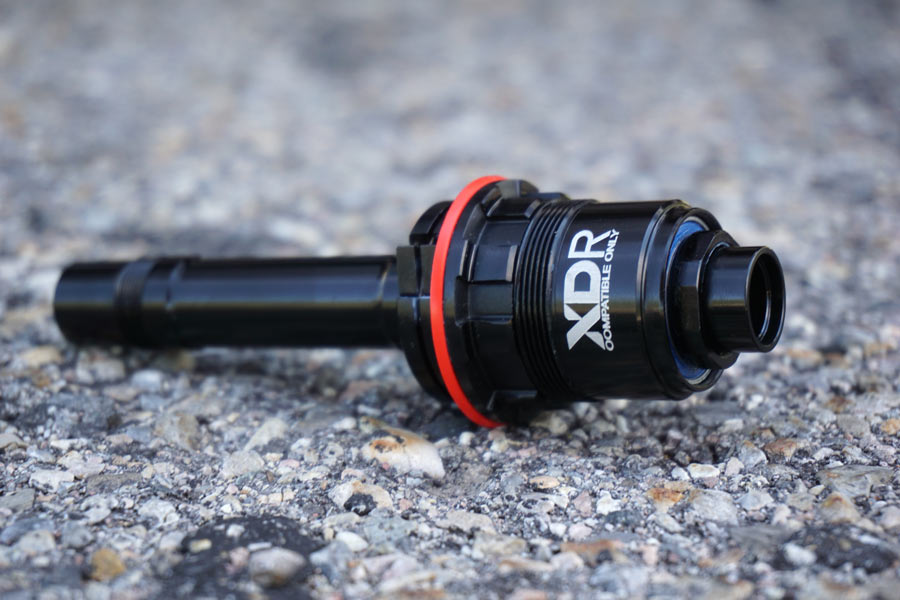
To make room for the 10-tooth cog, you’ll need to use the XDR freehub body, which is widely available on a number of hub brands. XDR is their road specific version of the XD driver that was introduced with the wide-range mountain bike groups years ago, and the difference is that they’re 1.85mm wider. This extra width is necessary to provide the right clearance for the cassette next to the spokes since road cogs aren’t as big and can’t dish like a 50-tooth MTB cog can.
Their main focus for development was 2x performance and endurance road bikes, which is why you see these tooth counts. Which means there’s room in the future for something like a 10-38 or 10-40 cassette for 1x gravel and cyclocross. But, in the meantime, the Eagle mountain bike cassette, though, is essentially a 10-42 with a 50-tooth bailout gear.
The smaller chainrings, along with the switch to their XDR freehub body and cassette, also let them reduce the minimum chainstay length to 405mm, down from 420mm, while still keeping proper chainline. It drops to just 395mm for 1x bikes. This is important for disc brake bikes, which originally required a longer chainstay length because they were using a 135mm wide hub standard (as opposed to 130mm for rim brake hubs). So this design allows the same shorter chainstay length as rim brake bikes enjoyed.
The new SRAM FlatTop Chain
To accommodate all of the gears in the system, they had to make the chain thinner. Which raised concerns about strength. By adding the material back at the top of the plate, as opposed to using the usual figure-eight shape, they gained back any strength that was lost to reducing the chain width. And it’s the same weight as the prior 11-speed chains.
The outer plates are thinner, but the overall proportions of plate thickness and internal space between the plates are all smaller now. Meaning this 12-speed chain is a lot thinner than the 11-speed one.
How much thinner? We’re working on that. But it got more narrower than the space between the cogs, so there’s actually more clearance between the chain and the cogs on either side of it, too, so it runs quieter. It’s a dedicated road chain, so it’s not compatible with their Eagle mountain bike groups. Why? Because these are designed to shift on the front, which their 1x MTB groups don’t need to do. Which means if you’re setting up a 1x bike with a mountain bike cassette, you’d use the Eagle 12-speed chain.
It also gets a hard chrome finish treatment, which improves its life by reducing wear by at least 50%. Put another way, it should last about 50% longer. And this also helps it reduce wear on the cassette, too, because as your chain deforms from wear, it starts to reshape the things it’s in contact with. Remember when shark tooth shaped chainrings meant they were really worn? That was caused by a worn-out chain being run well past its prime. So, when the chain lasts longer, the cassette and rings will, too.
New SRAM RED eTap AXS Shifters
Inside the shifters are faster chips, which means the whole system reacts more quickly to your shift inputs. The hood and handle shapes are similar to before, but the textures and paddle shape and size are more refined.
Reach adjust and bleed ports are up top, and the CR2032 coin cell battery that powers the wireless shifter now sits on the bottom of the lever body.
The pairing button is still on the backside of the paddle and is used to connect the shifters to the derailleurs during setup. Once that’s done, they can be used to trim the rear derailleur, and turn Enhanced Mode on or off without having to use the AXS smartphone app…keep reading.
SRAM RED eTap AXS Front Derailleur
Even with all the other news around this group, perhaps the biggest question we had was the FD’s battery-to-tire clearance. The original eTap front derailleur placed the battery far inboard, which limited its use for gravel bikes because it could potentially rub on anything bigger than a 40. Now, clearance is better by 2.5mm, which means you can now run tires that are 5mm wider overall. They say it’s good for a 700×42 with 415mm chainstays. Want bigger tires? Get a bike with longer chainstays or go 1x.
Now for the rest. There are geometry changes to the cage, made to accommodate the smaller gear combos, but they’ll still fit on existing road bikes using existing mounting standards. They shift a little quicker, too, because they have faster chips inside them, and the motor and gear units inside are new and faster, too. But not so fast that they’ll throw the chain.
More important than speed is accuracy, and SRAM Road PM Paul Cantor says it’s able to position itself more precisely based on where the chain is on the cassette, so there’s less chance the chain will rub, so it’s quieter.
SRAM RED eTap AXS Rear Derailleur
The new eTap AXS rear derailleur becomes 1x compatible thanks to an integrated motion control system. It’s a fluid damper, serving the same purpose as a clutch on mountain bike derailleurs, but does so without a mechanical clutch. Called Orbit, it’s essentially a speed sensitive damping system for the derailleur cage, and you can check out our patent coverage of the design right here.
Inside is a vane (think “paddle”) that moves through the fluid as the cage is pulled forward. So if you hit a big bump and the chain jumps and pulls the cage forward quickly, the fluid will resist that rapid movement of the vane. But the slow movement of a shift won’t create fluid drag, so it doesn’t sap power from the battery. Think of dragging your open hand through water – go slow and it’s easy, try to go fast and you feel a lot more resistance. They’re not calling it a clutch, but it basically does the same thing and will allow this system to work well in a 1x system on gravel and cyclocross bikes.
Side note: If you’re running a 1x system, the rear derailleur will actually shift a fraction of a second quicker because it’s not having to double check against front derailleur position.
There’s only one model now, no short- or long-cage options. Just one, and its length sits between short and long. Because the tooth count jumps are the same between all three chainring combos, it works, regardless of which cassette you pair with which chainrings. So, even though the pairings are designed for specific use cases, you can still mix and match.
Blips & Blip Box
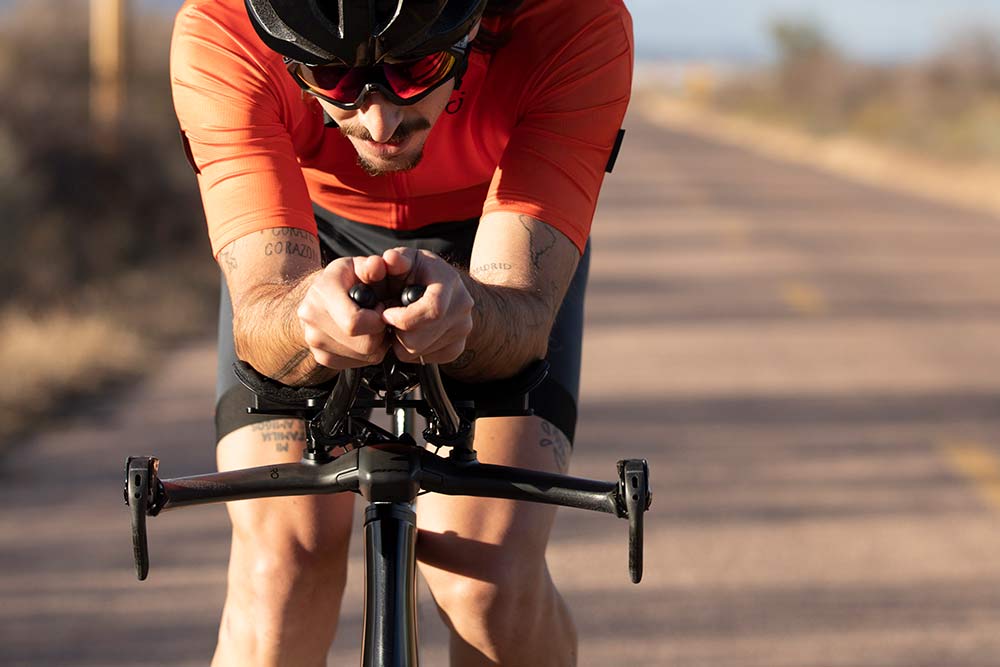
The Blip buttons themselves carry over unchanged, but the Blip Ports on the drop bar shifters are now independently assignable from the lever shifters. So, just because you have a Blip button plugged into the left shifter doesn’t mean it’s doing the same things as the left shift paddle…it could be set to shift the other direction, activate a dropper seatpost, or something else in the future.
The new Blip Box is about 50% smaller than the original, and there’ll be a new Zipp Vuka Aero cockpit (shown in photo above) that hides it inside a fairing for a cleaner, sleeker and more aero package. They say OEM partners are also looking at new ways to hide and integrate the Blip Box inside the frame, stem or aero bar…look for that in 2020 or 2021 models.
New rotors, same brakes
For traditionalists, they’ll carry over the mechanical rim brakes, and will have new eTap AXS shifters available with mechanical cable pulling levers. For the hydraulic brakes, the only real change is at the rotors, and even there it’s mainly cosmetic. The braking surface part of the rotor is the same, but there’s a new carrier that’s way better looking.
They say the vents and shaping were not done for heat management, but to our eyes it does look like it should provide more cooling surface area.
Tying it all together with the AXS app
For the full overview of how the new SRAM AXS family of components works together, read our AXS tech post. Here’s the summary recap specific to the road group. The new RED eTap AXS group doesn’t require you to use the app to ride it, but you’ll get more out of it if you do. Through the app, you can turn on “Enhanced Mode” that offers two different versions of auto-shifting: Sequential and Compensating.
Sequential mode will automatically shift the front derailleur as you move through the cassette to optimize the cadence steps. Compensating mode will, when you shift the front, automatically shift your rear derailleur 1-2 shifts in the appropriate direction, also to maintain a smooth cadence step. The idea is to keep you focused on the ride and let the computer figure out the best gear combo for you. You’ll need to input which cassette and chainring combos you’re using so it knows how to perform, but after it’s all set, you can simply turn it on or off using the trim buttons on the shift paddles…no need to pull out the app.
The app also has a mode control that lets you assign the shifters to different functions, swap which side does what, and turn the multi-shift on and off. Multi-shift is when you just hold down the paddle and it shifts through multiple gears. You can choose how many it’ll shift through at a time, limiting it to just 2 or 3 cogs, or letting it rip through the entire cassette if you hold it down long enough.
When is it available? What else? What’s next?
It’s available now. They wanted to have product ready at launch, so production has been running and things are shipping from the factory to be in the market today. Parts will be ready for aftermarket first, with limited availability on complete road bikes, too. They partnered with 15 brands to have bikes on sales throughout the world (we’ll have a post showing most of them later today). More complete bikes will follow in a couple months.
Force eTap AXS coming in April 2019, but they’re holding the details on that group until it launches. As for this RED group, we’ll have pricing and actual weights in our first ride review (links below).
What about mechanical groups? Will they see these same gearing and functional changes? We asked but haven’t received an answer yet. But our guess is yes, it’s almost certain that this new design will roll out to the mechanical shifting groups.
Important: Make sure you upgrade your indoor trainer to one of these new 12-speed cassettes and XDR driver body if you plan on using your bike on a trainer. They say Wahoo will have a driver body ready for their KICKR trainer very soon, and other trainer companies were alerted a while ago.
Want more? Here’s all of our tech stories from the SRAM AXS launch event:
